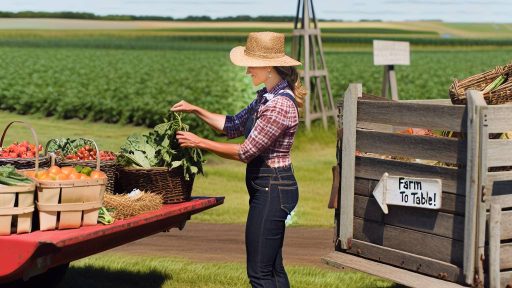Introduction to Import-Export Policies and Their Significance in Agriculture
Import-export policies play a vital role in agriculture.
These policies govern the flow of agricultural products across borders.
They influence local economies and global trade dynamics.
Strong policies help farmers access international markets.
Conversely, weak policies can stifle agricultural growth.
The Role of Import-Export Policies
Import-export policies dictate trade regulations.
They establish tariffs that affect pricing of products.
Moreover, these policies set quality standards for imports.
For example, strict quality controls ensure consumer safety.
In turn, this increases confidence in domestic products.
Impact on Agricultural Growth
Effective policies promote agricultural development.
They create opportunities for farmers to expand their markets.
Consequently, farmers can achieve better prices for their goods.
Increased revenue allows for investment in modern farming techniques.
This leads to improved crop yields and sustainability.
Transform Your Agribusiness
Unlock your farm's potential with expert advice tailored to your needs. Get actionable steps that drive real results.
Get StartedChallenges and Opportunities
Many challenges exist in implementing these policies.
Bureaucracy can create delays in trade.
Moreover, fluctuating market demands complicate policy effectiveness.
However, adapting policies to changing global conditions offers opportunities.
For instance, embracing technology can streamline export processes.
Case Studies of Successful Policies
Countries with strong import-export policies have seen growth.
For instance, New Zealand’s trade agreements benefit its dairy farmers.
Similarly, Brazil leveraged trade policies to boost soy exports.
Such examples demonstrate the potential of well-designed policies.
They highlight the importance of strategic global partnerships.
Current State of Agricultural Trade
Global Trade Trends
Agricultural trade has experienced significant changes in the past decade.
Global trade patterns reflect shifts in consumer preferences and economic conditions.
Notably, Asia has emerged as a major player in agricultural imports.
Countries like China and India have increased their demand for diverse agricultural products.
Moreover, the European Union remains a key market for agricultural exports.
These trends highlight the interconnectedness of global agricultural markets.
Statistics Overview
According to recent reports, agricultural exports reached $1.6 trillion globally.
The United States continues to be one of the largest exporters.
In fact, U.S. agricultural exports accounted for about $172 billion in 2022.
Additionally, Brazil has established itself as a leader in soy and beef exports.
These statistics demonstrate the ongoing growth in international agricultural trade.
Regional Insights
Each region showcases unique strengths in agricultural products.
- North America is known for its production of grains and livestock.
- South America excels in the cultivation of soybeans and coffee.
- Europe specializes in dairy products and wine.
Furthermore, Africa is experiencing a rise in agricultural exports, notably in horticulture.
Thus, understanding these regional dynamics is essential for trade strategy.
Showcase Your Farming Business
Publish your professional farming services profile on our blog for a one-time fee of $200 and reach a dedicated audience of farmers and agribusiness owners.
Publish Your ProfileBarriers to Trade
Despite growth, agricultural trade faces several barriers.
Tariffs and trade restrictions continue to hinder market access.
Moreover, fluctuating exchange rates can impact profitability.
Additionally, non-tariff barriers such as quality standards pose challenges.
Addressing these barriers is crucial for facilitating smoother trade routes.
Understanding Import-Export Policies
Definitions and Importance
Import-export policies refer to regulations governing international trade.
They influence economic growth and agricultural productivity.
Understanding these policies is crucial for farmers and exporters.
These guidelines help navigate market access and trade opportunities.
Types of Import-Export Policies
Import-export policies can be broadly categorized into two types: tariffs and non-tariff barriers.
Tariffs are taxes imposed on imported goods.
They can protect local industries from foreign competition.
Non-tariff barriers include quotas, licensing requirements, and standards.
These may limit the volume of imports or impose strict regulations.
Scope of Import-Export Policies
The scope of these policies varies by country and trade agreements.
They can affect agricultural exports significantly.
International agreements often dictate the terms of trade.
For example, the North American Free Trade Agreement (NAFTA) impacted trade between the U.S., Canada, and Mexico.
Additionally, policies can evolve based on global economic changes.
Impact on Agricultural Growth
Effective import-export policies can drive agricultural growth.
They enable farmers to access larger markets.
This access leads to increased revenue and investment in agriculture.
Furthermore, policies can enhance competitiveness of local farmers.
As a result, farmers adopt better technology and practices.
Find Out More: Choosing Between Crop Insurance and Comprehensive Farm Insurance
Identifying Key Players in Agricultural Trade
Role of Governments
Governments play a crucial role in agricultural trade policies.
They establish regulations that govern import and export practices.
Moreover, they create tariffs that can affect market prices.
Countries often negotiate trade agreements to facilitate exports.
Additionally, they may provide subsidies to support local farmers.
Effective policies can promote agricultural growth and sustainability.
Influence of Businesses
Businesses are vital players in agricultural trade dynamics.
They engage in production, packaging, and distribution of goods.
Private companies invest in technology to enhance productivity.
Furthermore, businesses often collaborate with farmers to ensure quality.
International corporations drive market demand for agricultural products.
They also adapt to regulatory changes to optimize operations.
Impact of Non-Governmental Organizations (NGOs)
NGOs significantly impact agricultural trade through advocacy.
They promote fair trade practices and sustainability initiatives.
NGOs often provide training and resources to farmers.
Showcase Your Farming Business
Publish your professional farming services profile on our blog for a one-time fee of $200 and reach a dedicated audience of farmers and agribusiness owners.
Publish Your ProfileThey raise awareness about the importance of ethical sourcing.
In many cases, they facilitate partnerships between various stakeholders.
These organizations contribute to enhancing community livelihoods.
Collaboration Among Stakeholders
Collaboration among governments, businesses, and NGOs is essential.
Strategic partnerships can address challenges in agricultural trade.
These alliances foster innovation and resource sharing.
Joint efforts enhance the effectiveness of policies and practices.
Ultimately, a collaborative approach drives sustainable agricultural growth.
You Might Also Like: Benefits of Comprehensive Crop Insurance for Modern Farms
Enhancing Agricultural Productivity Through Import-Export Policies
Understanding Import-Export Policies
Import-export policies play a crucial role in shaping agricultural growth.
They establish the rules governing trade between countries.
These policies influence the availability of resources and markets.
In turn, this affects agricultural productivity and farmer incomes.
Facilitating Market Access
Effective import-export policies enhance market access for farmers.
This access allows them to reach international and regional markets.
Consequently, farmers can sell their products at competitive prices.
This encourages them to produce more and diversify their offerings.
Additionally, it fosters a more dynamic agricultural sector.
Boosting Investment in Agriculture
Robust trade policies attract investments into the agricultural sector.
Investment leads to modernization and increased productivity.
New technologies improve farming techniques and output quality.
Moreover, investment in infrastructure supports efficient distribution.
Increasing Agricultural Efficiency
Import-export policies can enhance agricultural efficiency.
By allowing the import of essential inputs, farmers reduce production costs.
This approach ensures they have access to high-quality seeds and fertilizers.
Furthermore, it promotes the adoption of best farming practices.
Encouraging Sustainable Practices
Trade frameworks can promote sustainable agricultural practices.
Policies that support eco-friendly products enhance their marketability.
Consumers are increasingly seeking sustainably produced goods.
This shift creates opportunities for farmers to adapt to market demands.
Building Global Partnerships
Engaging in international trade fosters collaborative relationships.
These partnerships often result in shared knowledge and resources.
This exchange enhances agricultural innovation and growth.
Additionally, it opens avenues for research and development.
Responding to Global Market Trends
Import-export policies enable countries to respond to global trends.
By staying informed, farmers can adjust their production strategies.
This flexibility helps them meet consumer demands effectively.
Moreover, it allows them to navigate economic fluctuations more adeptly.
Explore Further: Adopting Food Safety Standards to Improve Farm Profitability
Challenges and Barriers in Implementing Effective Agricultural Trade Policies
Regulatory Complexity
Different countries impose varied regulations on agricultural imports and exports.
Showcase Your Farming Business
Publish your professional farming services profile on our blog for a one-time fee of $200 and reach a dedicated audience of farmers and agribusiness owners.
Publish Your ProfileThis complexity creates confusion for exporters and importers alike.
Moreover, navigating these regulations can be time-consuming and costly.
Market Access Limitations
Many developing countries face hurdles accessing global markets.
High tariffs and quotas often restrict their ability to compete.
Consequently, local farmers struggle to sell their products internationally.
Infrastructure Deficiencies
Inadequate transportation infrastructure hampers trade efficiency.
Poor road and port conditions contribute to increased delivery times.
This inefficiency results in higher costs for agricultural products.
Trade Disputes
Trade disputes between nations can cause sudden policy changes.
These changes disrupt established trade relationships and agreements.
As a result, agricultural stakeholders often face uncertainty.
Market Volatility
Fluctuating global prices for commodities can deter producers.
They may hesitate to invest in growth due to risk concerns.
This volatility makes strategic planning challenging for farmers.
Technological Barriers
Access to modern technology remains limited for many regions.
Without the proper tools, farmers cannot increase productivity effectively.
Additionally, technology adaptation can require significant training and resources.
Political Instability
Political factors greatly influence agricultural trade policies.
Instability can lead to abrupt changes in trade regulations.
This instability leaves farmers and businesses uncertain about future operations.
Find Out More: Farm Waste Management Regulations

Case Studies of Countries Successfully Leveraging Import-Export Policies
Exemplary Models from the Netherlands
The Netherlands leads in agricultural exports despite its small size.
Strong policies promote innovation and sustainability in agriculture.
For instance, they emphasized greenhouse farming techniques.
This method significantly boosts yields and reduces land use.
Consequently, the country became the second-largest agricultural exporter.
This achievement follows robust investment in research and development.
Success in New Zealand’s Dairy Sector
New Zealand transformed its dairy industry through strategic trade policies.
The government assisted farmers to enhance quality and export capabilities.
Cooperatives, such as Fonterra, exemplified this approach.
Fonterra focused on global markets, increasing competitiveness.
The result was a remarkable growth in dairy exports.
This strategic emphasis also improved local agricultural practices.
Chile’s Fruit Export Revolution
Chile has effectively utilized trade agreements to boost its fruit exports.
The country benefits from favorable trade conditions with major markets.
In particular, the Free Trade Agreement with the United States propelled growth.
Farmers adopted modern farming techniques to meet international standards.
As a result, exports of fruits like blueberries and avocados surged.
This illustrates the power of strategic trade policies in agriculture.
Brazilian Soybean Production and Export Strategies
Brazil emerged as a global leader in soybean exports in recent years.
Showcase Your Farming Business
Publish your professional farming services profile on our blog for a one-time fee of $200 and reach a dedicated audience of farmers and agribusiness owners.
Publish Your ProfileInvestment in infrastructure improved transportation for agricultural products.
The Brazilian government also established favorable trade policies.
These policies facilitated access to essential markets in Asia.
Consequently, Brazil’s soybean production has grown exponentially.
Such strategies demonstrate how import-export policies can drive growth in agriculture.
Best Practices for Policymakers in Designing Inclusive and Sustainable Trade Policies
Engagement with Stakeholders
Policymakers should actively engage diverse stakeholders.
This includes farmers, traders, and community leaders.
Regular consultations provide valuable insights and feedback.
Furthermore, engaging stakeholders fosters trust and collaboration.
Data-Driven Decision Making
Use reliable data to inform trade policy decisions.
Monitoring agricultural performance aids in identifying trends.
Additionally, data helps assess the impact of policies.
Ultimately, evidence-based approaches yield better outcomes.
Inclusive Policy Design
Design policies that are inclusive for all agricultural sectors.
Consider smallholder farmers and marginalized communities.
These groups often face unique challenges in trade.
Addressing their needs promotes equity in trading systems.
Environmental Sustainability
Integrate sustainability principles into trade policies.
Encourage practices that protect natural resources.
Sustainable agriculture enhances long-term productivity.
Incorporating eco-friendly measures benefits all stakeholders.
Capacity Building
Invest in training programs for agricultural participants.
Capacity building enhances skills in trade practices.
This approach helps stakeholders adapt to market demands.
Moreover, it fosters resilience against market fluctuations.
Monitoring and Evaluation
Regularly evaluate the effectiveness of trade policies.
Establish clear metrics to measure success.
Use findings to refine and improve policies continuously.
Moreover, transparent evaluation builds accountability.
Future Outlook: The Role of Technology and Innovation in Agricultural Trade Policies
Emerging Technologies in Agriculture
Emerging technologies significantly impact agricultural practices today.
Precision agriculture utilizes data analytics to enhance crop yields.
Farmers now employ drones for real-time monitoring of crops.
Genetic engineering also plays a crucial role in developing resilient crops.
These advancements ensure food security in a changing climate.
Innovations in Trade Policies
Trade policies are evolving to accommodate new agricultural technologies.
Governments are implementing regulations that foster innovation.
For example, countries are reducing tariffs on high-tech agricultural equipment.
Moreover, trade agreements now emphasize the importance of technology transfer.
This encourages the sharing of agricultural innovations across borders.
The Impact of Digital Platforms
Digital platforms enhance market access for farmers worldwide.
Showcase Your Farming Business
Publish your professional farming services profile on our blog for a one-time fee of $200 and reach a dedicated audience of farmers and agribusiness owners.
Publish Your ProfileE-commerce allows farmers to sell directly to consumers.
This reduces reliance on traditional supply chains and intermediaries.
Additionally, farmers can access information quickly through mobile apps.
These platforms improve transparency and efficiency in agricultural trade.
Investment in Research and Development
Investment in agricultural research and development is crucial.
Public and private sectors must collaborate to fund innovative projects.
Research leads to new technologies that can boost productivity.
Furthermore, it drives sustainable practices in farming.
Ultimately, innovation leads to improved trade opportunities for farmers.
Future Challenges and Opportunities
The future of agricultural trade will face several challenges.
Climate change impacts food production and trade patterns.
Additionally, geopolitical tensions can disrupt supply chains.
However, these challenges present opportunities for innovation.
Farmers and companies must adapt and innovate to thrive.
Strategic Recommendations for Maximizing Agricultural Growth Through Trade
Enhancing Trade Agreements
Countries should pursue beneficial trade agreements actively.
These agreements can lower tariffs on agricultural products.
Consequently, farmers will have better access to markets.
Additionally, reducing trade barriers promotes competition.
This can lead to innovation and growth in agricultural practices.
Investing in Infrastructure
Investments in infrastructure are crucial for agricultural success.
Improved transport networks facilitate easier access to international markets.
Furthermore, efficient storage facilities can reduce losses post-harvest.
These steps collectively enhance the supply chain for farmers.
Supporting Local Farmers
Governments should prioritize programs that support local farmers.
Access to finance enables farmers to invest in quality seeds and technology.
Training programs can teach better agricultural practices and techniques.
Such investments in farmers lead to sustainable growth.
Utilizing Technology
Embracing technology can significantly boost agricultural productivity.
Precision farming techniques enhance resource efficiency.
Moreover, digital platforms can connect farmers to global markets.
Adopting innovative tech solutions promotes competitive advantages.
Fostering International Collaboration
International collaboration can optimize agricultural policies globally.
Sharing successful practices between countries can yield positive outcomes.
Furthermore, joint ventures can help access bigger markets.
This cooperative approach will drive agricultural innovation forward.
Encouraging Sustainable Practices
Sustainable farming practices should be encouraged worldwide.
These practices enhance food security and environmental health.
Moreover, they can lead to better trade opportunities in eco-friendly products.
Thus, promoting sustainability aligns with global trade trends.
Additional Resources
USDA Invests Nearly $2 Billion, Leverages American Agriculture to …
Showcase Your Farming Business
Publish your professional farming services profile on our blog for a one-time fee of $200 and reach a dedicated audience of farmers and agribusiness owners.
Publish Your Profile



